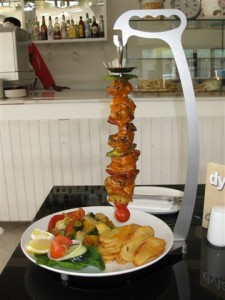I’m sure I’m talking to many chill-weary ears when I mention that February is the perfect time for a trip south and a good thaw. Anyone growing up in the northeast US or Canada has been conditioned to feel the pull of Florida and other warmer climes once winter has exerted its icy claws for a few months. Considering that, it feels a little odd that this is conditioning is lacking in my current surroundings in Spain. Winter getaways to warmer climes are rather a rarity in these parts.
Even though this year’s winter in Barcelona, I’m told, is windier and colder than normal, there still isn’t a rush to sandy shores. For one thing, there really isn’t a “European version” of Florida or the Caribbean. It’s actually quite a haul to find beaches warm enough to work up a decent case of lobster skin.
Despite this, finding somewhere sunny was definitely on my mind a few weeks back when we started pondering getting out of town for a few days during Liam’s winter break. (I should mention that this is the first of two winter school breaks here, since every good holiday deserves another in the Spanish way of thinking.) But with hot not in the cards, we instead aimed for reasonably warm and interesting.
Off we went into the friendly skies last weekend via a couple of short flights to the Portuguese archipelago of Madeira. Thanks to the gulfstream, these islands enjoy a mild climate year round and at least a chance at seeing 70-degree weather in February. Not beach perfect, but certainly good for a relaxing break. And at $400/person for flight and five nights in a hotel, it also was feeling like good value.
We hopped on a local bus to depart the island airport and one big fact became apparent within minutes. The main island of Madeira is less of an island and more like one big cliff. Literally, there was not a piece of flat land in sight anywhere. Staring higher up the continuous hill, I spied some cows and couldn’t help but think of the end result should one go cow-tipping. The poor creatures wouldn’t stop rolling until landing with a splash in the Atlantic. That’s one hell of a way to tenderize beef.
After our late afternoon arrival, there wasn’t much left on the day’s agenda beyond finding a decent meal and settling in. I’ve always believed that these early moments are a great test of a destination. Can one roll the dice and find a good meal on a whim, or is the stage set for struggles ahead? Fortunately, we landed squarely on the former.
Faced with a line of restaurant choices, we took a chance on a place called O Dragoeiro for less than scientific reasons. The set menu looked fair, the setting was a rustic garden with lots of natural appeal and, to be honest, the old guy pitching the place out front wasn’t short on charm, although he was short on teeth. In fact, he was probably about 70% shorter on teeth than most of us. Some might suggest that’s a warning sign, but I instead focused on his ample paunch and decided if he could carry that weigh t despite being every dentist’s nightmare, the restaurant must be doing something right.
t despite being every dentist’s nightmare, the restaurant must be doing something right.
An hour later, sated with fresh seafood and the local specialty of meat on a two-foot skewer (known as an espetada), it was clear we had chosen well. It was an omen of things to come. Over the course of the next five days, not a bad meal was to be had. This island clearly had a love of food.
We centered the trip in Madeira’s capital city of Funchal, a welcoming hamlet of about 130,000 residents. It stretches out to newer sections, but the center is an old town of narrow streets, tiled sidewalks and historic buildings. In the midst of the old section is the local market, the perfect spot for those in search of tropical fruits and typical veggies.
I’m partial to an offshoot of passion fruit commonly known as a granadilla. It’s a hard-shelled, orange fruit filled with black seeds in a mucus-like covering. Writing that, I’m aware that the fruit’s appeal sounds about equal to soup made from my son’s boiled gym socks. Nonetheless, they are a quite tasty mix of sweet and sour, but often hard to find.
Madeira grows granadillas in abundance, but, more surprisingly, they also have a half dozen other variations on passion fruit that were new to me, with flavors varying from pineapple to banana to tomato. Wandering among the fruit stands, we met vendors who have the pitch down to a science, slicing up fruit and doling out samples in a fashion that would put Saturday morning at Costco to shame. Seriously, my dad would have hired any one of these guys to sell cars. They live by the rule that nobody gets away without a bag in hand!
Not surprisingly, I walked out with a sack overflowing with passion fruit, mango and bananas. It was only based on sheer weight that I skipped the fresh avocados, which were so big they looked like a steroid experiment gone wrong but tasted like green perfection. I did make up for that miss by ordering avocado with vinaigrette as a dinner appetizer on three occasions. The Madeirans should export this concept, because it really is a terrific starter.
 Along with the abundant exotic fruits, Madeira is also famous for local wine. It’s pretty common for restaurants here to give a small sample of the local vino as a welcome when you enter. I’m not nearly as big a fan of the Madeira wine as I am of Port, but it is an interesting taste and the bottles with simple white stenciling look tailor-made for display on a home bar.
Along with the abundant exotic fruits, Madeira is also famous for local wine. It’s pretty common for restaurants here to give a small sample of the local vino as a welcome when you enter. I’m not nearly as big a fan of the Madeira wine as I am of Port, but it is an interesting taste and the bottles with simple white stenciling look tailor-made for display on a home bar.
I’ve long been a believer that Portugal is vastly underrated for both its eating and drinking options, and Madeira quickly gave me plenty of reasons to back up this belief. More to come in my next post, but safe to say that the choice of Madeira for a winter trip was not causing any heartburn even if it wasn’t a beach break.
RANDOM THOUGHTS: One other nice thing about Funchal is the fact that things are open regular hours, including Sundays, as opposed to the hit or miss opening hours in Spain. Trying to buy something on Sunday even in Barcelona is a needle in a haystack experience, with one minor exception being bread. It’s somehow ironic that bakers are the only ones who can’t get Sunday off… It’s a little disconcerting to start a vacation sitting on the tarmac knowing that your tight connection time is getting tighter by the minute thanks to a mysterious delay. Thankfully, airlines now pad travel times to allow for airport congestion and other issues, meaning leaving late often still means arriving on time. Of course, this does raise the question, when you do depart on time, how come you don’t arrive early? Along with luggage, airlines seem to have mastered making extra time disappear also. Cue the Twilight Zone music…

